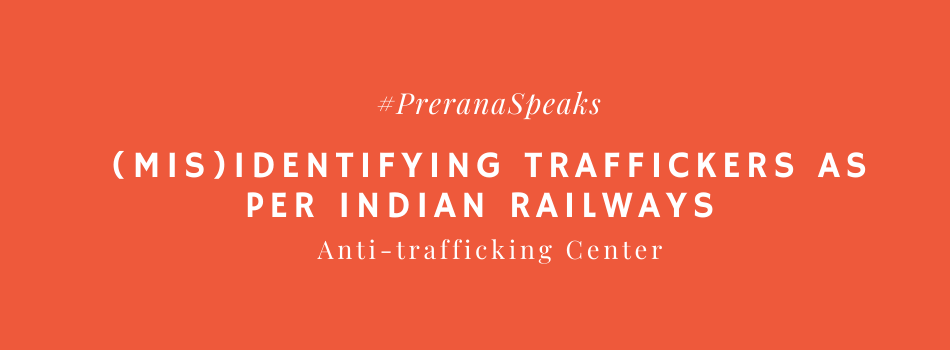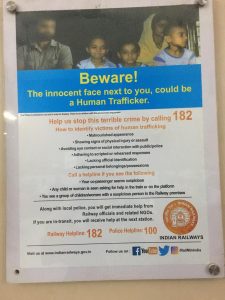
(mis)Identifying Traffickers as per Indian railways - Prerana's Perspective
Azra Qaisar
DOCUMENTATION & COMMUNICATION MANAGER
Human Trafficking is a disguised crime and is not often easy to identify. In our trainings, with various stakeholders, we often emphasize that there are no set characteristics of gender, class, caste, or race that can be used to identify a trafficker or a victim. While communities that are less empowered socio-economically, tend to be more vulnerable to trafficking, it would be a generalization to claim that they are the only ones who get trafficked. A public awareness poster on human trafficking that is often used by the Indian Railways, and has been in use for at least two years now, has steered us again to discuss the issue of identification of traffickers and victims, and the politics of the image.
A case of bias

The poster, which has been published in newspapers and can also be spotted at many railway stations, seeks that travelers stay alert while traveling to the presence of a victim of trafficking while traveling on the train. The intent of the poster is well-meaning, which is to prevent trafficking and to enable early interception. However, the poster itself creates misleading ideas of how traffickers or victims can be identified.
The poster reads “Beware! The innocent face next to you could be a human trafficker”. The poster features an adult male, three children, and an adult female. In the version that was printed in newspapers, the face of the adult man has been blurred, leaving one a little confused about who the poster is claiming to be the trafficker. (The one referred in this blog has been taken from the twitter handle of Central Railways – see here). Since innocence is an attribute usually used to refer to children, a cursory look at the poster leaves one with the assumption that the child is being referred to as the trafficker. Even if this is overlooked, there is another crucial issue in the messaging of the poster. The representation of the people makes it look like they all belong to lower socio-economic groups, indicating that these are the groups to which traffickers and victims belong. While lower socio-economic classes are more vulnerable, generalization may not be the fairest and accurate way to represent either victims or perpetrators.
The identification of a victim through ‘malnourished appearance’, ‘lacking official identification’, ‘lacking belongings/possessions’ can be said to be indicative of a class bias. In a country where a significant part of its population suffers from malnutrition and is often not aware or literate enough to possess official documentation, a poster like this can cause more harm by creating a stereotype about what a victim looks like. It also raises questions on whether the same criteria and attitude towards identifying traffickers would be employed in the First Class coaches of trains, or for those that use the airways, and belong to higher socio-economic groups, and hence may not fit the aforementioned description.
The poster makes a dangerous assumption of who a trafficker is, and unfairly assumes that only people with less financial means would resort to the crime. In a country, where there seems to be a pattern of laws being more often used against the poor, than the privileged, a poster as this comes across as irresponsible and misleading. It feeds into the society’s biases against certain groups which could lead to travelers becoming vigilantes, and wrongly identifying people as traffickers, based on their own biases. This could target innocent people in a bid to deliver instant street justice.
Defining suspicion
The poster further asks the travelers to contact their helpline, if a traveler seems ‘suspicious’ or if they spot a group of children/women with a ‘suspicious’ person. It is pertinent to note here that a person’s notion of suspicion is guided by their own socio-economic position. India is a very diverse nation with various communities, languages, cultures, and also biases. What seems suspicious in one region, or to one community, or one ideology, may not seem so to another. Vague language like this could cause more harm than help since it asks people to apply their social bias to identify what qualifies as ‘suspicious’. If a child has signs of physical abuse and looks under duress, it is important to ask a child if they are in distress before taking any action. Otherwise, the situation can become a harrowing experience for the child if they are made to go through questioning, subsequent procedures, and are separated from a trusted adult.
As observed in recently identified trends by Prerana too, traffickers often avoid traveling with the victims too. They might get into the train one station later and get off one station earlier to avoid being seen with the victims. Hence the clues given in the poster may not be quite relevant and hence, dated too. Apart from this, the assumption of ‘stranger danger’, overlooks situations where traffickers are known to the victim. In our experience, we have come across cases where the trafficker is a parent or a guardian. This is especially true of cases of inter-generational trafficking and labor trafficking. In such cases, the traffickers may be able to present all documents to show their relationship with the child and hence, not come under the scanner. We also have come across cases where the victims are migrating illegally, with the trafficker. There are also situations where the victim does not even know that they are being trafficked and may be under the assumption that he/she is traveling to a new location for better opportunities. In such situations, the victims tend to protect the trafficker, and may not think of them as a stranger or dangerous, and also testify to state that they know and trust the trafficker. The poster, thus, runs a few steps behind the strategic intelligence applied by the traffickers.
Need for better communication
While we acknowledge that traffickers use the railways as a means to transport victims from the source to the destination and that travelers must be aware, it is equally important to not encourage misrepresentation. There is a stereotype about the ‘villain’ in our minds, guided by our class and caste biases. In our experience of working with victims of human trafficking, we have observed that traffickers often belong to varied socio-economic backgrounds, and we try to highlight the same through our training and our meetings with stakeholders. The poster also uses the images of children below 12 years but our field experience (documented in our Andhra Pradesh Report, and Indo Nepal Cross Report) tells us that children of older age groups are often victims of trafficking. Invasion of privacy and targeting of people from lower socio-economic groups could be potential outcomes of generic guidelines and must be avoided.
In the recent past, India has witnessed many cases of mob justice and vigilantism upon suspicion. Public awareness posters must strive to be more responsible in their language and imagery to ensure that they serve the purpose that they have been designed for, instead of furthering unfair assumptions. It is essential that they do not feed into those biases when asking the public to be alert. Better and balanced communication to spread awareness should be the way forward.
To be or not to be? Questions on motherhood searching answers
The blog post was first published on Dr. Pravin Patkar's Blog 'Expressions'. The post sheds light on the impact and Read more
In the current COVID and lockdown situation, one of the adversely affected communities is the migrant communities. Our Sanmaan project Read more



